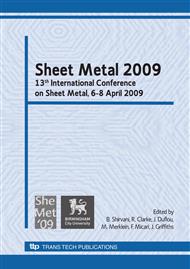p.467
p.473
p.481
p.493
p.503
p.511
p.521
p.533
p.543
Double Indentation of Laser Welded Butt Joints of Stainless Steel Sheets
Abstract:
In this study, an easy and innovative technique for laser welded butt joint characterization is proposed. AISI 304 sheets, 1.25 mm in thickness, were welded in the butt configuration by means of a high power diode laser (HPDL). Different combinations of the process parameters were considered. For each combination, during the process different thermal cycles were induced in the material generating heat affected zones, which were subsequently tested by the double indentation test method. This test was performed on the sheets by means of two co-axial flat indenters, 1 mm in diameter, made of tungsten carbide (WC); the upper indenter penetrates at a constant rate (0.1 mm/min) into the material, whereas the lower indenter acts as a support. On each side of the seam, 10 indentations were performed at fixed positions with different distance from the centre of the seam, to obtain a load map correlated to the mechanical properties. By comparing the maps of the different laser welded joints, a clear effect of the laser scan speed and the power was found. Furthermore, a wake field effect is recognizable, in fact the loads are symmetric as regards the seam, and there is a clear trend in the direction of the laser path. These results confirm the effectiveness of this method, which is also suitable for on-line application because a very small indentation is left on the sheet.
Info:
Periodical:
Pages:
503-509
Citation:
Online since:
March 2009
Authors:
Price:
Сopyright:
© 2009 Trans Tech Publications Ltd. All Rights Reserved
Share:
Citation:


